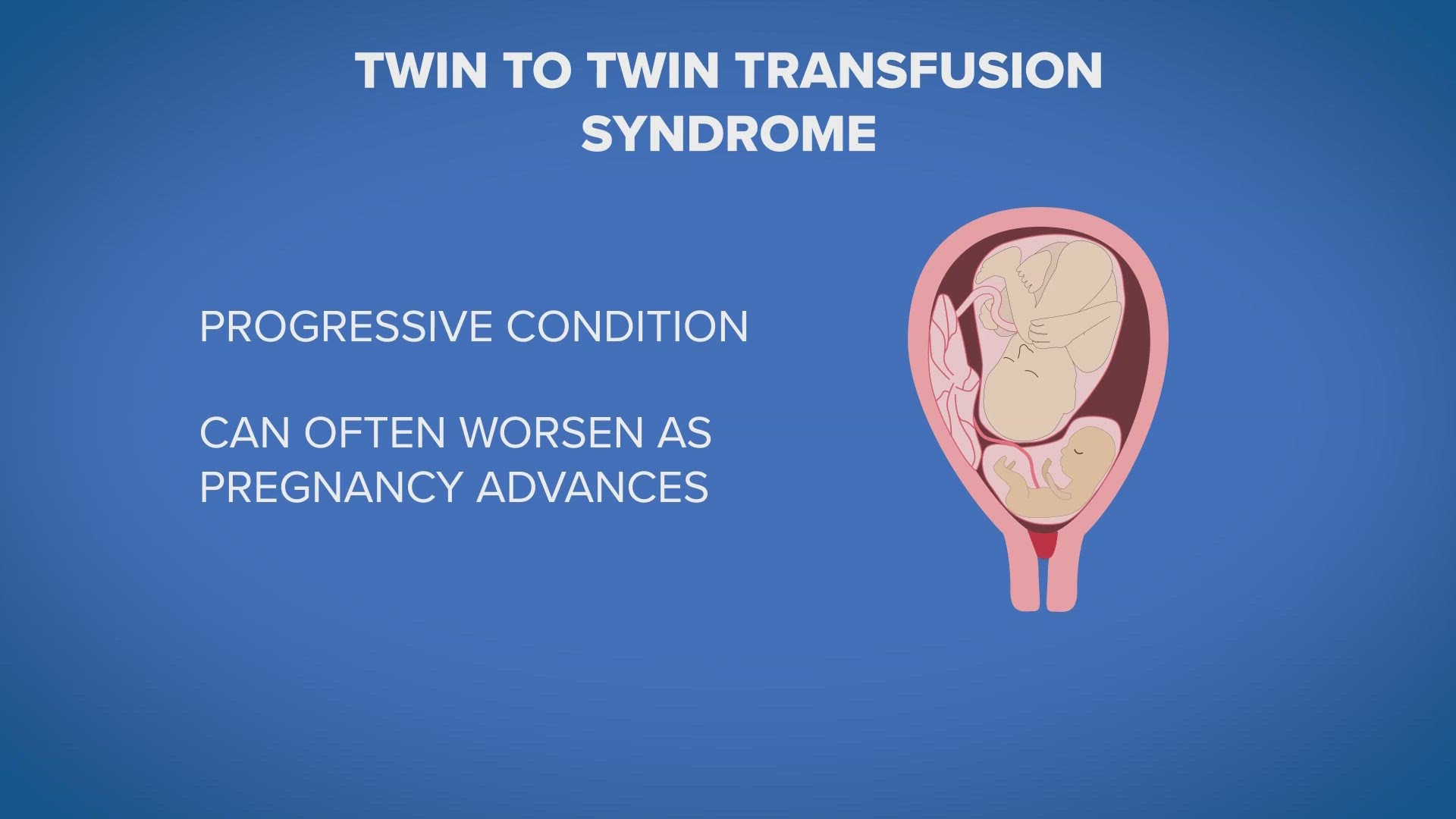CLEVELAND — Tierra and Justin Koch were ready to give their toddler, Aria, a sibling. They were thrilled to learn they were pregnant, then shocked when they saw the ultrasound.
"Last January, we found out we were pregnant," Tierra remembered. "Then in February, a day after our daughter's second birthday, we found out we were having twins."
It was big news, to say the least, and they admit their world flipped over. Then, it flipped again at 18 weeks.
The couple learned their identical twins had what's known as Twin-to-Twin Transfusion Syndrome, or TTTS. It's a rare condition in which the blood flows unequally between monochorionic twins.
"Monochorionic twins share the placenta, but they're each in their own bag of water (amniotic sack) within that placenta," Dr. Ellie Ragsdale, a maternal fetal medicine specialist and director of fetal intervention at University Hospitals Cleveland Medical Center, said. "They have vascular connections where they share their blood flow in their nutrition, but TTTS is when they don't share that blood flow and nutrition equally, and that affects about 10-15% of monochorionic or identical twins."
The Kochs, who live in central New York state, were told to find a center that could provide a surgical option that could separate the blood vessels of the twins and give them a chance. Time was critical, and they had a choice of New York City or Cleveland.
"Twin-to-Twin is a progressive condition that often gets worse rather than gets better, and as we proceed down the pathway, both babies develop heart failure and ultimately it results in loss of one or both babies," Ragsdale admits. "And because those babies are connected with vascular connections, if one baby passes, unfortunately, it can have catastrophic neurologic complications for the baby that survives."
In some cases, the condition can resolve on its own, but within just a few days, the Kochs' case became critical.
They chose to come to University Hospitals Ahuja Medical Center, the first in Northeast Ohio to offer fetoscopic laser surgery lead by Dr. Giancarlo Mari.
"He was one of the pioneer doctors to help grow this practice," Justin said, "so it kind of gave us the ease of mind that we made the right choice."
Mari is an accomplished physician-scientist with international renown in the fields of fetal diagnosis and intervention, and the former chair of obstetrics and gynecology at the University of Tennessee. Currently, he is overseeing ultrasound and fetal therapy while leading the growth of University Hospitals' expanding fetal care program.
Despite more than two decades of experience, Mari explained this surgery is essentially a last resort in advanced cases like the Kochs.
"The most important thing is to be honest," Mari told us. "When a patient comes to see us, we always give her names and addresses of other institutions for a second opinion if they are willing to go to these other places, because we want to make sure that when the patient decides to stay with us, it's very important that the couple understands that, yes, things can go well, but there is always a risk."
That risk can be substantial and decisions can be gut-wrenching, and that's why each couple meets with Nurse Katie Fioritto to help guide them.
"Ultimately, it is up to the patient," Fioritto said. "I mean, even when laser is what we recommend, if someone's not comfortable with that or if they prefer to go the amino reduction route, we're going to support that."
By the time the Kochs arrived in Cleveland, their situation was dire.
"He told us about the laser surgery, and he said, 'Either you do this and we can potentially save one or both babies, or you don't get it and you would potentially lose both of them," Tierra remembered.
At just over 18 weeks, and with time running out, the couple named the twins Liam and Levi. Tierra went to Cleveland for the minimally invasive procedure.
"The hallmark gold standard treatment for Twin-to-Twin Transfusion is laser ablation," Ragsdale said. "We basically separate those vessels within the placenta to create two placentas, essentially, so those babies can't take nutrition from each other."
The surgery saved baby Levi, but tragically could not do the same for Liam, who passed 24 hours later. It was a bittersweet outcome for the Kochs, who grieved the loss of Liam but were grateful for procedure, especially as they welcomed Levi at 29 weeks.
Levi would spend 71 days in the NICU, but today is thriving at home, under the loving care of his parents and big sister. The Kochs say a return trip to Ohio is in the works.
"We're actually planning to return, hopefully, this summer to the hospital in Cleveland and have Levi meet the staff that saved his life," Justin said.



